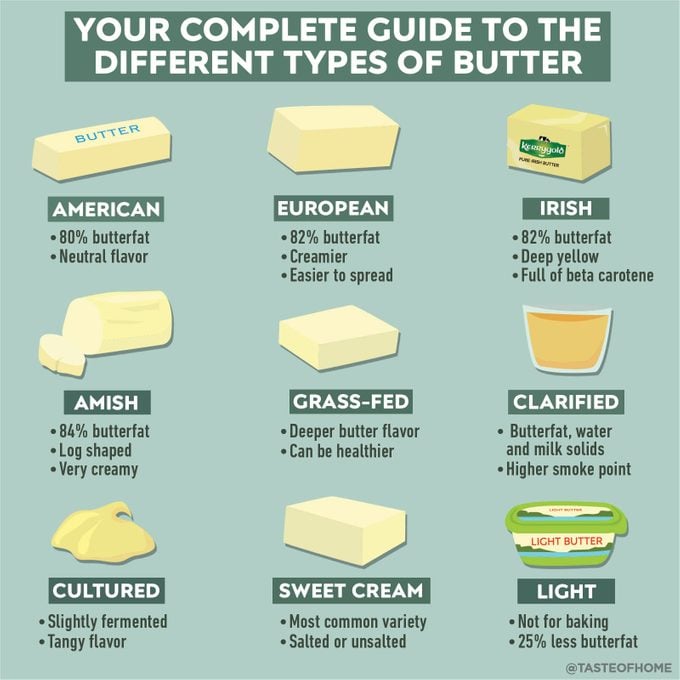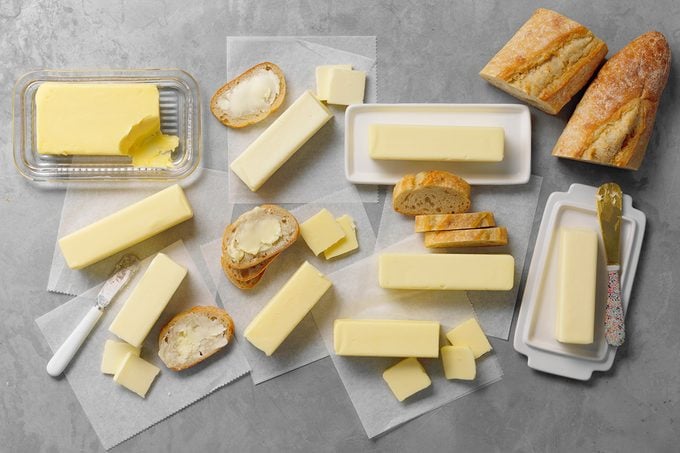Your Complete Guide to the Different Types of Butter
Updated: Mar. 14, 2024
It's no secret that butter makes everything better. Get the lowdown on all the types of butter in our guide!
Slathered on bread, baked into a flaky pie crust or dripping from an ear of corn, butter is a popular fat that we can’t get enough of. But with so many options on the market, how do you know which one to buy? Brush up on your knowledge to start churning out better recipes in your kitchen.
Editor’s Tip: Butter keeps well in the fridge, but can you freeze butter?
Types of Butter
Follow along as we explain the differences between popular butter types—from Amish to clarified. You butter be prepared for this breakdown.

What is American butter?
Traditional American butter is exactly what you picture when you think of butter: stick-shaped and sold in both unsalted and salted varieties. American-style butter is required by the USDA to have 80 percent butterfat, making it have a more neutral, milder flavor in comparison to other varieties of butter. American unsalted butter is best used for baked goods, whereas American salted butter can be used in just about anything else since it enhances the flavor of any dish it’s added to.
What is European butter?
European butter is churned longer than American butter to reach 82%, and those two tiny percentage points make a big difference! Not only is European butter creamier and easier to spread, but it’s also richer and more flavorful, too. It’s ideal for pastries and pie crusts, where the butter flavor really shines.
Depending on the part of Europe the milk originates from, the butter can vary widely in texture, color and flavor. Climate, processing and breeds of cows can all affect the butter.
What is Irish butter?
Like other European butters, Irish butter has 82% butterfat. Many consider Kerrygold butter, a popular Irish brand, to be a buttery pot o’ gold, and for good reason.
Irish butter’s deep yellow color and rich taste set it apart from other varieties. The secret? Those lush green fields of Ireland! The grass is chock-full of beta carotene, which is present in the milk the grass-fed cows produce. It gives the butter its rich color and flavorful taste.
What is Amish butter?
You know what they say, if it’s not broke, don’t fix it. That’s exactly what we love about old-fashioned Amish butter. Traditional Amish butter is made by churning cream that has a high dairy fat content. Because of this high butterfat content (around 84%), it’s a lot creamier in texture than European and American butter. But don’t worry, you don’t need to travel to Amish country to get this butter today. You can also find Amish butter in most big-box stores in its traditional one- to two-pound log shape.
What is grass-fed butter?
Grass-fed butter is made with milk from cows that graze on green pastures, in Ireland or anywhere in the world. This grass-only diet creates a richer, deeper butter flavor. Not only is the butter more flavorful, but it may be healthier than butter from grain-fed cows, whose diet may include hormones and antibiotics. Grass-fed butter is full of healthy fats and fat-soluble vitamins, more omega-3 fatty acids and fewer toxins.
What is clarified butter?
Butter is composed of three elements: butterfat, water and milk solids. When you clarify butter, you remove the milk solids and water, leaving the butterfat. Clarified butters, like ghee, have a higher smoke point, which makes them great for cooking and sauteing. Plus, the process is super easy to do.
What is cultured butter?
If you think of yogurt when you see cultured butter in the store, you’re on the right track. Live bacterial cultures are added to the cream and left to ferment before being churned into butter. The slightly fermented cream gives the final product a tangy flavor.
What is sweet cream butter?
The most common butters are sweet cream butters, made with fresh cream instead of a cultured or sour cream version. While sweet cream butter can come in salted or unsalted versions, it can sometimes be used as a synonym for salted butter, so look carefully if you’re searching for a specific kind.
What is light butter?
If you’re planning on using light butter in your recipes, you may want to rethink it. Light butter is traditional butter that was churned with more air and water. With 25% less butterfat than traditional butter, it’s better as a spread than in your baking.
Common Butter Questions

Curious about the difference between salted and unsalted butter? Or which butter tastes better: hand-rolled or stick butter? Wonder no more.
Is there a real difference between Grade AA and Grade A?
Established by the USDA, butter grades are assigned based on flavor, body, color and salt. Grades AA and A are typically found in grocery stores, while Grade B butter is more often found in industrial settings. Here’s the breakdown:
- Grade AA butter is the highest grade and “possesses a fine and highly pleasing butter flavor.” It’s smooth, creamy, easy to spread and made of high-quality cream.
- Grade A butter features “a pleasing and desirable butter flavor.” That means it may have a stronger flavor and is slightly coarser than Grade AA.
- Grade B butter “possesses a fairly pleasing butter flavor,” isn’t as fresh and can be crumbly or sticky.
Is hand-rolled butter better than sticks?
Typically wrapped in parchment paper, hand-rolled butter usually comes in one- or two-pound logs that are scooped out of the churn and hand-rolled while the butter is still soft, as opposed to being molded into sticks, cut and wrapped by a machine. Neither butter is better than the other, it’s really up to your personal preference and what you’re using it for.
If you’re logs of butter for baking, be sure to have a kitchen scale on hand. Logs don’t come with convenient measurements on the packaging.
Should I use salted or unsalted butter?
You’ll find that most butter varieties come in both unsalted and salted versions. The key difference between salted vs. unsalted butter is obviously the amount of salt, which can vary from brand to brand. Unsalted butter allows you to control the amount of salt in your recipe, while salted butter has a longer shelf life. Here are some of our favorite tips for storing butter.
Can’t get enough butter? Find out the difference between shortening and margarine. Or better yet, learn how to make butter at home!
